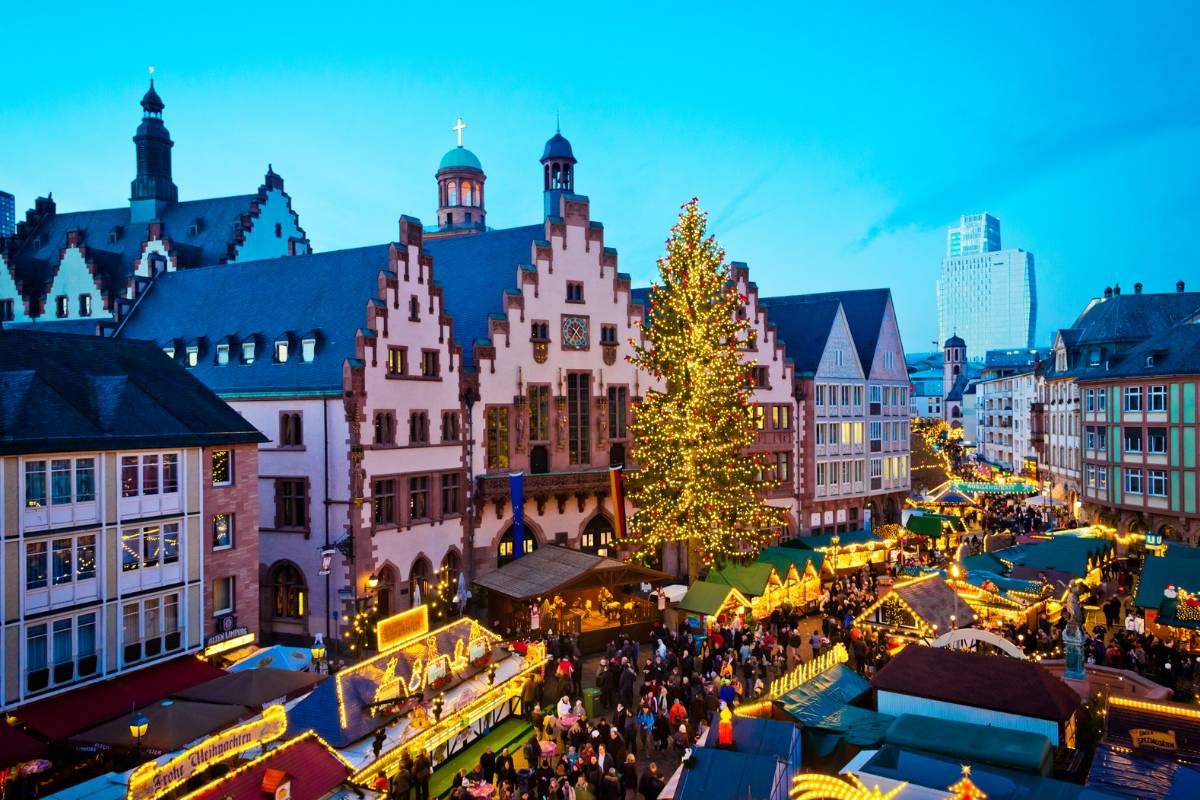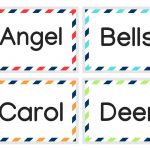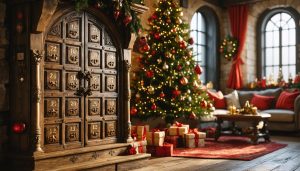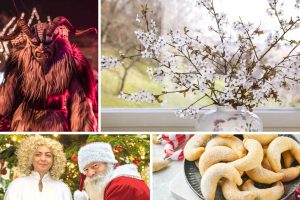I spent many Christmases in Germany, where my grandparents live, and it was magical every time. From meeting friends at Christmas markets to making the advent calendar, Germans have so many Christmas traditions that even non-religious people like to celebrate the festive season.
Here is an overview of how Germans celebrate Christmas and some of their most popular traditions.
Christmas Markets in Germany
German Christmas markets are truly a unique experience, unlike anything else. These markets are some of the oldest and most traditional in the world. They offer various goods and services you won’t find anywhere else. From handmade decorations to delectable treats, there is something for everyone.

Here are my top three:
Nuremberg Christkindlesmarkt
The Nuremberg Christkindlesmarkt is one of the best Christmas markets in Germany. It is the oldest and most traditional market, established in the mid-16th century. The Christmas tree is the centerpiece of the market, and thousands of tiny lights are strung up to create an atmosphere of festive cheer. There are also over 180 wooden stalls that sell a variety of gifts, decorations, food, and drinks. You can find handmade toys and delicacies such as lebkuchen (gingerbread) and gluhwein (mulled wine).
Dresden Christmas Market (Dresden Striezelmarkt)
My second favorite Christmas market in Germany is in Dresden, the Striezelmarkt. This market stretches for almost 1km and offers over 200 stalls with hand-crafted goods, food, decorations, artwork, and more. Many activities are also available to visitors, including ice skating and caroling sessions. The famous “Dr. Quendts Dresdner Christstollen” can also be purchased here!
Berlin Lucia Christmas Market
The Berlin Christmas market – WeihnachtsZauber Gendarmenmarkt – is another great Christmas destination in Germany. This market showcases some of the city’s best craftspeople who offer unique jewelry and pottery items. In addition to shopping opportunities, there are plenty of attractions, such as ice skating rinks, live music performances, and theater shows for all ages to enjoy throughout the season.
What Makes the German Christmas Market So Special?
The Atmosphere
One thing that sets German markets apart from the rest is the atmosphere they create. The brightly lit stalls, the fairy lights, festive music, and holiday decorations create an incredibly inviting atmosphere that feels like something out of a fairytale. This helps make them a popular destination for everyone who wants to experience the country’s culture first-hand during the festive season.
Shopping and Activities
At German Christmas markets, you can find winter activities like ice skating rinks, carousel rides, and Ferris wheels. There is plenty to do besides browsing for presents or enjoying festive snacks. Generally speaking, there’s no such thing as “too much Christmas cheer,” – so be prepared to get into the holiday spirit!
Many markets also offer other traditional entertainment options like plays and puppet shows. These shows are often performed by local entertainers with strong ties to their communities, which makes them incredibly authentic experiences that can’t be found elsewhere.
Food and Drinks
From sweet treats like gingerbread and lebkuchen to savory snacks like sausages and pretzels, there’s no shortage of delicious dishes.
- Mulled Wine (Gluehwein) is a popular German Christmas drink with red wine, sugar, and spices. It’s served hot in traditional mugs that can be taken home as souvenirs.
- Feuerzangenbowle (or Weihnachtspunch) is similar to mulled wine but with an extra shot of rum.
- Eggnog (Eierpusch) is made with eggs, milk, and sugar, usually flavored with brandy or cognac and topped with whipped cream.
- Gingerbread (Lebkuchen) is typically made with honey, nuts, spices, and other ingredients like cocoa or chocolate.
- Chestnuts (Maronen) are also popular during the holiday season and can be found at most Christmas markets. They’re either roasted or boiled and served with sugar and butter.
Christmas Traditions in Germany
Advent Wreath (Adventskranz)
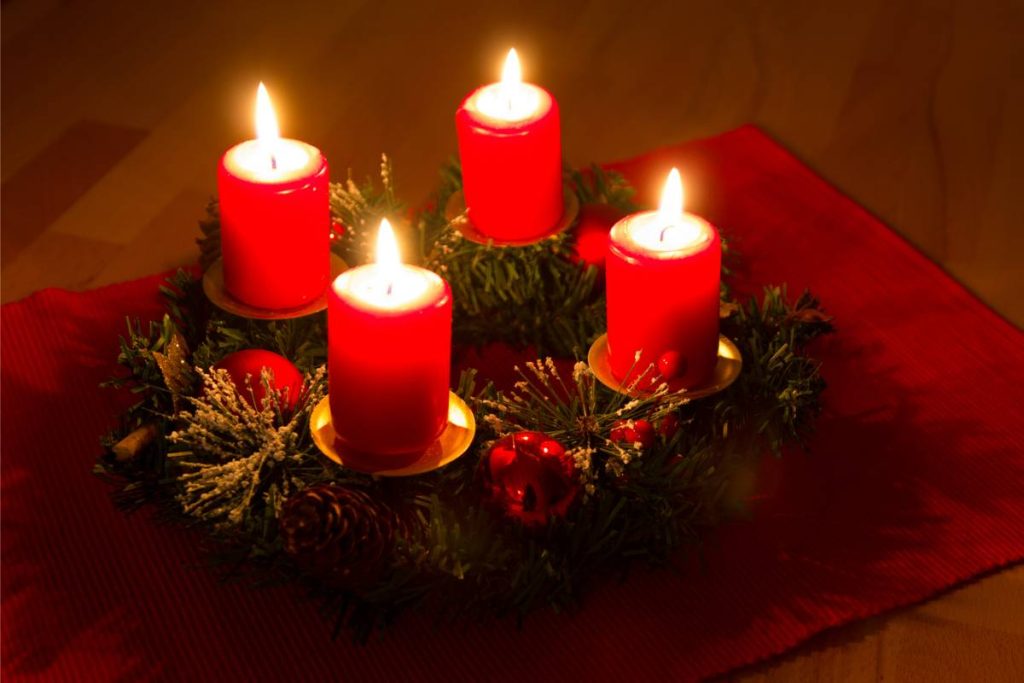
The Advent wreath can be found in most German homes. They are popular Christmas decorations and a big part of Christmas celebrations in Germany. Christmas wreaths are commonly used to count down the days until Christmas in Germany. They have four candles (usually red or white) lit each Sunday leading up to Christmas Day. On the last Sunday before Christmas, all four candles are lit.
Advent Calendars (Adventskalender)
I think of German Christmas traditions, I think of Advent calendars. Most calendars are handmade and feature 24 numbered doors that open up to reveal small surprises like chocolate or holiday trinkets. It is almost a bit of a competition between the parents who makes the best Adventkalender for their child.

Saint Nicholas Day (Nikolaustag)
December 6th is the feast day of St. Nicholas, or Nikolaustag, as it’s known in Germany. The night before Saint Nicholas Day, children leave their shoes outside the door, and St. Nick rewards them with small gifts. Some kids dress up and walk from shop to shop or house to house, singing Christmas songs to get treats. Imagine it like the Christmas version of Halloween.
It’s also a popular tradition for adults to exchange small Christmas gifts on this day.
Christmas Eve (Heiliger Abend)
Germans celebrate Christmas on Christmas Eve (Heiliger Abend), the 24th of December. Many German families finish decorating the Christmas tree before Santa Claus comes with presents.
Some kids sing Christmas songs or read a poem for Santa Claus before they get their Christmas gifts. Other families follow the tradition of Christkind (Christ Child) bringing presents while the kids wait outside. The kids wait for a bell to ring. Once the bell rings, the kids can come inside, where the family sings carols before the opening of the gifts (Bescherung) begins.
A festive dinner or supper, including traditional dishes like roast goose, carp, or fondue, usually follows this.
Afterward, some attend local church religious services while others play Christmas games.
Christmas Day (Erster Weihnachtstag)
On Christmas day (December 25), family and friends get together to enjoy a traditional German lunch, mainly roast dishes like Christmas goose or duck.
It’s not uncommon for Germans to visit extended family and friends on Christmas day. Shops and malls are closed, and people usually spend time inside or go for walks to burn extra festive calories.
Christmas Tree (Weihnachtsbaum)
The Christmas tree is traditionally decorated on Christmas Eve, just a few hours before midnight. Germans take great pride in their decorations, often homemade ornaments, garlands, and Christmas lights. The tree is usually placed in the living room, and the lights are turned on only when it’s dark outside.
Some families wait until the first Sunday of Advent to put up their trees, as this is when the Christmas season officially begins.
Epiphany and the Sternsinger (Dreikonigstag)
The Epiphany, or Dreikonigstag, is celebrated on the 6th of January and marks the end of the Christmas season in Germany. On this day, children dress up as “the three kings” and go from house to house to sing Christmas carols and receive treats and donations for different children’s causes. This is known as Sternsinger in German or “star singers” in English.
Popular Christmas Food in Germany
Many traditional dishes are served during the holiday season in Germany. Some of the most popular include roast goose, carp, fondue, and dumplings. Gingerbread (Lebkuchen) is also a staple at Christmas time. It’s often decorated with colorful icing and small candies.
Christmas Cookies (Plaetzchen)
Cookies are also very popular during the holidays and can be found in almost every bakery and coffee shop. They are usually made with butter, sugar, eggs, flour, and spices like cinnamon or nutmeg, but since my family is vegetarian, I only make vegan Christmas cookies.
Stollen
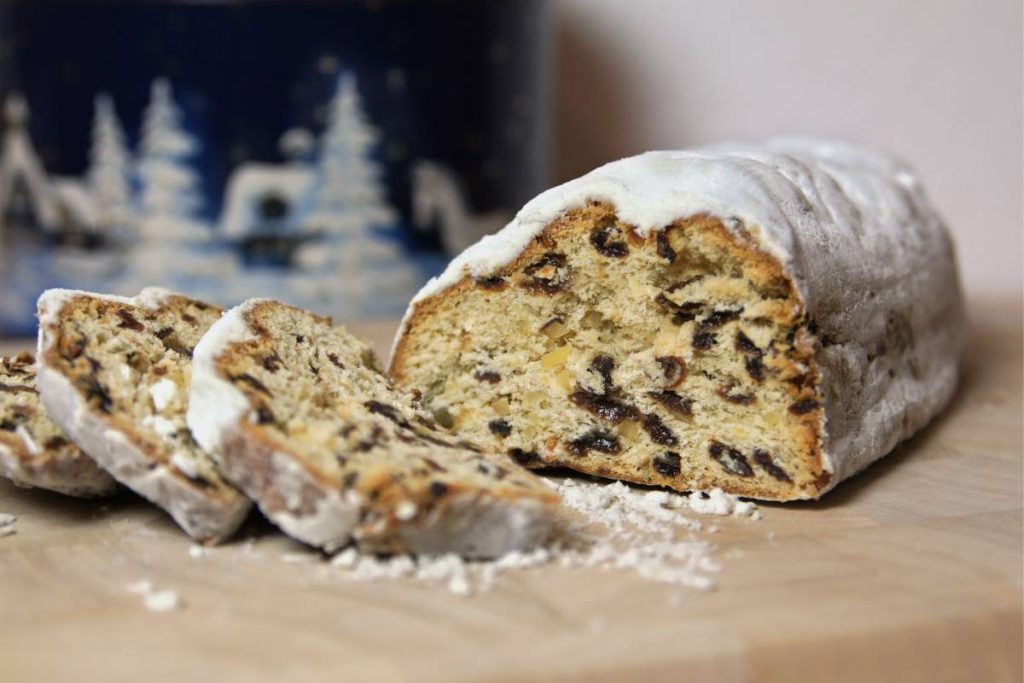
Stollen is a traditional German Christmas cake with dried fruit, nuts, and spices. It’s often shaped into a circular loaf and decorated with powdered sugar or icing. You can buy this sweet bread at any bakery during Advent time.
Lebkuchen
Lebkuchen is gingerbread made with honey, spices, and nuts. It’s usually formed into a circular shape or decorated with icing and small candies.
You will also find many gingerbread houses, decorated little houses made mainly of gingerbread. It developed from the fairy tale “Hansel and Gretel,” in which the wicked witch lives in a gingerbread house.
Weihnachtsgans (Christmas goose)
Christmas goose is roasted and served with red cabbage, potato dumplings, and gravy. The tradition of roast goose goes back to St. Martin’s goose, which was actually eaten before the beginning of Advent. Advent used to have the character of a period of fasting. This ended with the Christmas mass, so a goose was prepared as a festive roast.
However, as I mentioned before, my family and I are vegetarians, and I do not support the terrible mass killing of geese during the festive season.
Fondue
Fondue is basically melted cheese and you dip in bread. Many enjoy it as an appetizer or as the main course of a meal. Most fondue recipes include Emmental, Gruyere, Appenzeller, and other types of Swiss cheeses.
Raclette
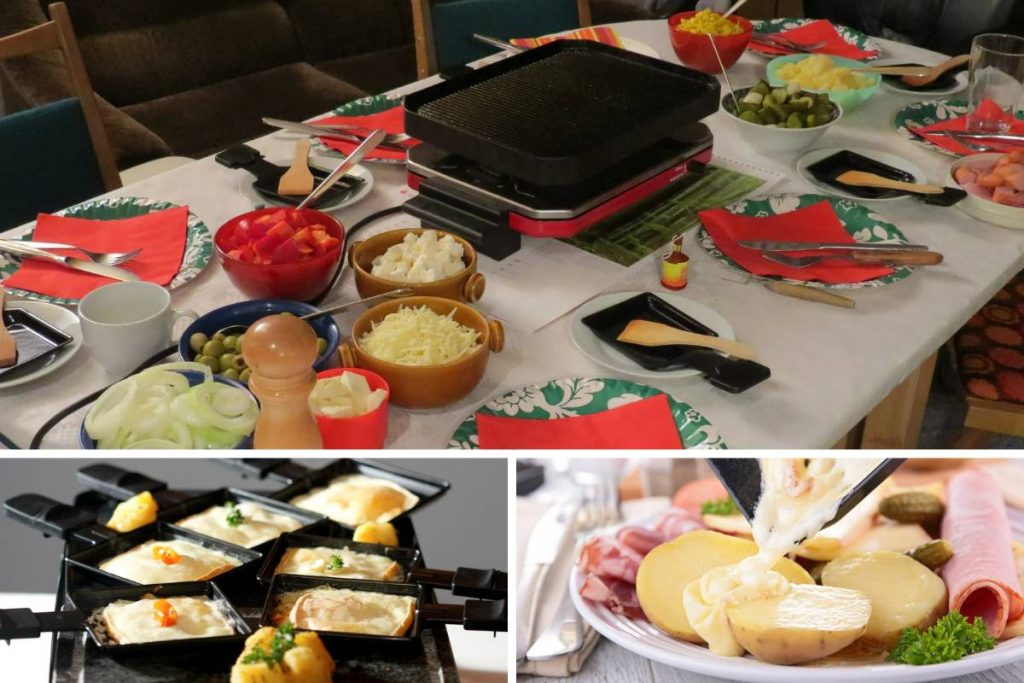
Raclette is a great interactive vegetarian hot cheese dish often served during the holiday season and on New Years Eve. All you need is an electrical raclette grill, cheese, potatoes, vegetabes and whatever else you like to fill the raclette pan with.
Kartoffelsalat mit Wurst (Potato salad with sausage)
The traditional recipe for Kartoffelsalat mit Wurst usually includes potatoes, onions, celery, pickles, and sausage cooked in a vinegar-based dressing. Some variations may include adding bacon or other types of meats, such as ham. It’s usually served cold and consists of potatoes, onions, celery, bacon or sausage, and mayonnaise.
This hearty salad is a popular holiday dish because it is easy to prepare, so nobody has to spend many hours making food in the kitchen.
Bratapfel (baked/roasted candy apple)
It is hard to imagine Advent without the pleasure of roasted apples in the oven. Bratapfel is usually made with roasted or baked apples and then filled with raisins, nuts, and spices.
Marzipankartoffeln (marzipan potatoes)
Marzipan potatoes are small candies made from marzipan that have been shaped and colored to look like potatoes. This traditional German treat is typically enjoyed on St. Nicholas’ Day and Christmas Day.
Where to Spend Christmas in Germany
Germany is known for its traditional culture and its delicious cuisine, but during the holiday season, Germany also offers some stunning winter landscapes that make it an ideal destination to escape the hustle and bustle of everyday life. If you’re looking for a place to spend Christmas in Germany, here are three destinations I can recommend:
The Black Forest
The Black Forest (or Schwarzwald in German) is a region located in southwestern Germany and one of the most popular tourist destinations in the country. This area is well known for its picturesque views filled with rolling hills, crystal clear lakes, pristine forests, snow-capped mountains, and quaint villages. During the holiday season, many people flock to this area to go skiing, snowboarding, or sledding at one of its many ski resorts. It’s also home to some stunning Christmas markets filled with handmade decorations, delightful aromas from traditional foods, sparkling lights, and festive music.
Berlin
Berlin is Germany’s vibrant capital city and one of the top places to experience Christmas like a local. Every year there are countless markets throughout Berlin where visitors can find an array of local delicacies, festive decorations, and handcrafted gifts. Visitors can also take advantage of Berlin’s iconic landmarks, such as Brandenburg Gate, or check out the amazing light installations at Zoo Lights or Winterfestilluminationen parks.
No visit to Berlin would be complete without witnessing magical performances at Potsdamer Platz or any of the many other theaters around town offering seasonal productions.
Munich
Munich is located in Bavaria and has been dubbed “the Christmas capital” due to its abundance of seasonal activities. Some traditional events include ice skating at Marienplatz Square or enjoying Glühwein (mulled wine) and Lebkuchen (gingerbread cookies) from the numerous festive stalls throughout Munich’s streets.
One highlight during this time is the “Tollwood Winter Festival,” with over 200 stalls selling regional specialties such as sausages and beer!
Munich also has also plenty of cultural attractions during wintertime when temperatures drop, such as Nymphenburg Palace or St Peter’s Church Altar, featuring beautiful works from early Renaissance artisans.
No matter which destination you choose for your holiday in Germany, there’s something for everyone during this special time of year – from outdoor winter sports activities to cozy nights spent by a fire drinking mulled wine and admiring charming decorations throughout German cities!
Three Popular German Christmas Songs
1. O Tannenbaum (Oh Christmas Tree)
A classic Christmas song that everyone knows:
2. Stille Nacht, Heilige Nacht (Silent Night)
One of my favourite Christmas carols are the Clare College Singers. In this video you can sing along to the classic German Christmas carol “Stille Nacht”!:
3. Vom Himmel hoch, da komm’ ich her (From Heaven High I Come to You)
This version of the song is from the Universitäts Chor München:
How to Say “Merry Christmas” in German
To wish someone a “Merry Christmas” in German, you would say “Frohe Weihnachten.” This translates literally to “Happy Christmas” but is more commonly used than the literal translation. It is also common for people to exchange gifts over the holiday season in Germany, and these gifts are normally opened on Christmas Eve or New Year’s Day.


